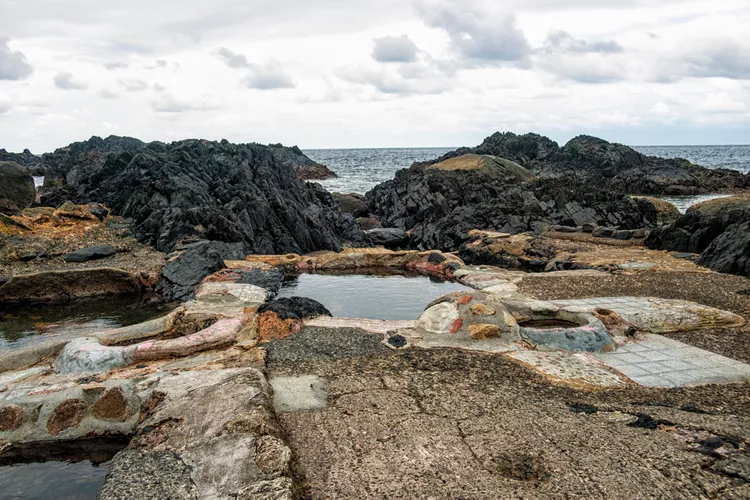Summary
- Togura Kanze Onsen — Chikuma, Nagano Prefecture
- Tenzan — Hakone, Kanagawa Prefecture
- Hirauchi Kaichu Onsen — Yakushima Island, Kagoshima Prefecture
- Yu-no-sato — Unzen, Nagasaki Prefecture
- Shitan-yu — Shichirida Onsen, Oita Prefecture
- Onto — Nagato Yumoto Onsen, Yamaguchi Prefecture
- Matusiro-sou — Matsushiro, Nagano Prefecture
- Monju-no-yu — Kakeyu Onsen, Nagano Prefecture
- Sahako-no-yu — Iwaki, Fukushima Prefecture
- Naminoyu ‘Akane’ — Unzen, Nagasaki Prefecture
Wellness-oriented escapes are trending today; however, ancient Japanese bathing traditions date back thousands of years. The island nation in East Asia is home to numerous geothermal hot springs, known for their healing benefits—such as promoting circulation, soothing sore muscles, and relaxing the mind.
Over time, a ritualized bathing culture has developed around onsens (naturally warmed, mineral-rich waters). Consequently, specific protocols, customs, and etiquette must be respected by both locals and travelers alike.
For those considering this age-old pastime, it’s crucial to honor the enduring history and heritage of these public hot springs. Soaking in these communal spaces is typically gender-separated, and many establishments may not welcome guests with tattoos. If you’re inked, it’s advisable to research ahead to avoid being turned away. “Before entering an onsen, it’s customary to rinse off,” advises Keiko Watanabe, the spa and wellness manager across the Hoshino Resorts portfolio. “After getting out, don’t forget to drink plenty of water and moisturize.”
Scroll on to discover some of the best public hot springs in Japan, as recommended by local experts.
01. Togura Kanze Onsen — Chikuma, Nagano Prefecture
“A popular pit stop for tourists heading to Zenkoji Temple in nearby Nagano, Togura Kanze Onsen brims with emerald green hot springs,” says Watanabe. The moderate temperature allows for longer soaks, enabling visitors to enjoy the relaxing benefits. “The sulfur content also makes the skin supple, so after bathing, you will emerge feeling rejuvenated,” adds Watanabe.
02. Tenzan — Hakone, Kanagawa Prefecture
Among Japan’s most favored hot springs towns, Hakone offers a plethora of tranquil locations to unwind. Nature enthusiasts will connect deeply with the Earth at Tenzan, featuring naturally heated outdoor rock pools surrounded by lush trees, alongside a bathhouse nestled within a traditional structure.
03. Hirauchi Kaichu Onsen — Yakushima Island, Kagoshima Prefecture
Located at the southern tip of Yakushima Island and accessible only during low tide, Hirauchi Kaichu Onsen is an open-air, sulfuric hot spring cascading from below sea level. “The stunning coastal views make for an incredibly unique soaking experience,” notes Simon Metcalfe, manager at the Kyushu Tourism Promotion Organization.
04. Yu-no-sato — Unzen, Nagasaki Prefecture
Yu-no-sato is a historic public onsen in Unzen, recognized as the oldest communal bath in the region. Visitors flock here to enjoy the healing effects of the hot, acidic, iron-rich hot springs. Watanabe advises that the heat can be quite intense, so practicing kakeyu (using buckets of water outside the tub before soaking) is essential, especially for first-time visitors.
05. Shitan-yu — Shichirida Onsen, Oita Prefecture
Konoha-no-yu offers a recently renovated area known as Shitan-yu, which boasts the most concentrated carbonated spring in all of Japan. The cooler temperature, coupled with bubbling effects, invigorates the body and makes it possible to enjoy extended baths comfortably.
06. Onto — Nagato Yumoto Onsen, Yamaguchi Prefecture
Onto exemplifies the fusion of rich hot spring traditions with modern aesthetics. This stunning facility recently reopened in historic Nagato Yumoto Onsen, offering a rejuvenating experience with lukewarm, alkaline water that gently smooths the skin and purges impurities.
07. Matusiro-sou — Matsushiro, Nagano Prefecture
What was once a well-kept healing secret for the army of the powerful daimyo Shingen Takeda, Matusiro-sou has become a celebrated spa retreat in the castle town of Sanada Jumangoku. Concentrated iron deposits impart the hot spring’s golden hue and a variety of health benefits, including reduced fatigue and improved skin health.
08. Monju-no-yu — Kakeyu Onsen, Nagano Prefecture
The tradition of bathing at Monju-no-yu spans more than 1,200 years. The hot water is particularly soothing for the feet and lower back. “A brief soak of about five minutes can be quite refreshing,” says Watanabe. “However, it’s advisable not to stay too long to prevent overheating.” Surrounded by several sacred sites, it’s an excellent location for a stroll following your visit.
09. Sahako-no-yu — Iwaki, Fukushima Prefecture
Located in a hot spring town with over a millennium of history, Sahako-no-yu is a public bathhouse dating back to the Edo period. “The high temperature and sulfur in the water provide various health benefits, and there are renowned cherry blossom viewing spots nearby,” explains Watanabe. She recommends practicing kakeyu before immersing yourself, starting by dipping your feet and gradually working your way up.
10. Naminoyu ‘Akane’ — Unzen, Nagasaki Prefecture
Many view Naminoyu ‘Akane’ as the premier outdoor hot springs facility in Obama Onsen, a picturesque resort town on the eastern shore of the Shimabara Peninsula. In addition to the chance to relax in some of the hottest spring waters, visitors are treated to breathtaking views of the Tachibana Gulf and enchanting sunsets.




